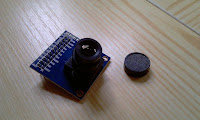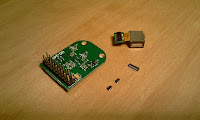frequency: 434.287Mhz
modulation: RTTY, 100 baud, 8N2, 450Hz shift
date: 26th August 2016
time: 6:00-7:00UTC (8:00-9:00CEST)
place: Roznov pod Radhostem, CZ
balloon: Hwoyee 1600
payload: TT7F tracker, Mobius ActionCam, parachute (155g)
gas: Hydrogen (1.996m3)
target neck lift: 626g
target ascent rate: 4m/s
predicted burst altitude: 42383m
predicted time to burst: 177min
A year after my unideal 40k attempt with TT7-40, I have finished the first 'light' version of the new TT7F tracker and I intend to test it with an UP and DOWN flight. Initially, I wanted just a smaller balloon without a camera, but as I got to the planning itself, I couldn't resist to have another go at 40km with a proper 1600g balloon. Another motivator was the fact that I still haven't managed to get a video of a full flight. With TT7-40 the camera gave up after 5 hours some 15 minutes before the delayed burst.
That led me to the first upgrade. I exchanged the 2400mAh LiPo battery for a bigger 3200mAh one. That meant 24g mass increase (42g to 66g) while potentially providing about 1.5 hours additional recording time (taking into account the expected decrease in the battery's capacity at low temperatures). The first freezer test with just the camera and the battery in a sealed bag (to avoid humidity) didn't go that well. A direct contact between the battery and a frozen chicken turned out to be beyond its low temperature tolerance and it stopped recording after about 2 hours (kept on recording after being warmed up again outside the freezer).
For the payload box, I used a simple design carved out of a 2cm thick board of extruded polystyrene. I also made openings for the camera's buttons and LEDs in the top to be able to control it even after the payload is all sealed.
This time, the package coped with -18°C inside the freezer so well that the recording stopped only after filling the whole 64GB SD card some 9 hours later.
Another issue that I wanted to improve upon from the last time was stabilizing the camera and avoiding
excessive rotation. I started by ordering ball bearing swivels to use in a few places.
Next, I tried to equip the box with a couple of stabilizing elements. I then watched it perform in gust wind and had it record sample videos for comparison. It turned out that although the elements reacted to the wind and turned in its direction it may not be what you want in a situation where the winds come in gusts from different direction. The best footage came out of the most uniform payload without any additional elements.
One more thing about the camera. Since the LiPo battery compared to the original one is too big to fit inside the camera's casing, it has happened to me a couple of times that a slight unintended pull on the extension cord led to the camera switching off. The battery connector on the PCB is quite small and probably not robust enough to withstand all sorts of pulling without temporarily stopping power going in. I tried testing this with my payload box by furiously shaking it and throwing it around. The camera kept on recording despite all of this so I consider the payload being prepared for such inconvenience.
This specific TT7F tracker doesn't have the LTC3105 nor the MT9D111 connector and regulators soldered on. Since I am still some time before finishing and properly testing the SSDV capabilities, I decided to fly a 'light' version of the tracker this time. With this version's current consumption of about 130mA (when powered by a LiPo ~3.7V), I opted for two AAA batteries to power it and fitted a standard AAA battery holder on the backside of the tracker.
The Energizer Ultimate Lithium batteries should offer about 1200mAh while weighing 15g. With those I did another freezer test.
The resulting data as received directly from the tracker show that the two Energizers managed to power the tracker for 7.5 hours before dying. One thing I haven't solved about the tracker is a relatively high volatility of the ADC measurements when powered through the TPS63031 (battery powered). When the tracker is powered via the USB interface, the measurements are much more stable.
For the actual flight, I constructed a 434MHz ground plane antenna from a guitar string (0.2mm thick) as used on some previous light weight floaters.
The dimensions were 164mm for the driven element and 328mm for the ground plane strings. Attached were to the GND pads and vias on the bottom of the PCB.
This antenna weighs only 0.26g.
The new antenna tested at about 400m with line of sight. Both RTTY and APRS packets decoded without problems.
The finished tracker weighs 8.39g while with the batteries the total rises to 23.57g.
The tracker also transmits an APRS packet once a minute. However, the Si4060 transmitter is equipped with 434MHz matching and the antenna is likewise designed for the same band, so the transmitted power at the 2m band (144.8MHz) isn't great. I managed to decode the packets myself from a few hundred meters distances even with some obstacles in the way.
However, I wasn't able to reach a proper IGate. Here, I was hoping to be heard by one at the top of the mountain in the distance (18.6km). The tracker still had just a piece of wire instead of the ground plane antenna at that time, and the balloon's altitude may provide a better path for the signal, but the APRS performance is an open question.
I also tested the whole set running as it was supposed to to verify that there was no interference from the camera to the GPS module. There are three ball bearing swivels in this setup. One underneath the camera box holding the tracker on a string. The second at the top of the camera box and the third at the balloon end of the cord. Despite that I noticed that the swivel's ability to counteract the rotations depended on the type of string used.
Initially, I opted for the bottom white string due to its lower weight (0.68g per meter). However, the string seemed to be a little elastic and kept acumulating energy that led to continual rotations and counter rotations of the payload. The tricolour string (0.64g per meter) suffered from similar problems. In the end, I found the upper white string to improve the swivel's performance significantly, but it was bought out by its higher mass (1.23g per meter). The cord's material is probably braided nylon while the unsuccessfull candidates were cotton made.
This is the final payload box with all the cords. The knobs tied from the nylon cord didn't seem to by very secure, so I rather sewed the endings together to make sure. The string between the payload box and the tracker is approximately 1m long while the one between the box and the ballon is 4m. I also secured the tracker's string around the battery as opposed to just relying on the extruded polystyren not riping apart.
The payload box with the camera, battery and all the strings weigh 115.41g.
For the parachute, I decided to try and make one based on Ed Moore's instructions from his UKHAS talk. It's a cross form parachute with an area of 0.145m2 (length 0.55m, width 0.153m) made of Skytex, a material used in paraglides.
After initial tests, I replaced the white cotton cords with the tricolour ones because of too much tangling. The finished parachute weighs 12.56g plus 1.39g for another swivel.
Here, I am testing the parachute with a 200g weight. Equations suggest a landing speed of 4.7m/s with a 150g payload and 6.7m/s with 300g. The total mass to be lifted by the balloon is about 155g. However, it is problematic to predict how much of the balloon itself will remain attached to the system after burst and even more problematic to estimate how much drag will the balloon remnants add to the parachute's drag. Nevertheless, these are the parameters I am going with.
Contrary to my previous two flights, I decided to use hydrogen this time. It is much cheaper than helium and has lower density as well, so it should allow the balloon to ascend even higher. This is a 40l cylinder filled to 150atm giving 5.6m3 of usable gas. It is about 1.7m tall and weighs 50kg, so it isn't ideal for too much moving and handling.
I had in hand only one regulator that turned out to have a reverse thread so it wouldn't fit. Trying releasing a little gas by slightly turning the valve directly turned out to be doable, therefore I'll simply fasten a hose to the output and fill the balloon this way.
I couldn't resist. I had to verify that it really was hydrogen :-).
Adding it all together, the tracker's 23.57g, the parachute's 13.95g and the remaining payload's 115.41g total to 152.93g to be lifted (further calculations will consider 155g to account for any aditional ties). For intended 4m/s ascent rate, the Random Engineering's calculator gives 626g neck lift for 177 minutes of ascent to 42383m burst altitude.
This is the latest prediction some 24 hours before the launch. I made a few of them with varying parameters. The purple dots are ascent rate of 3 and 5m/s. The blue dots are descent rate of 5 and 10m/s. And the red dots are burst altitude of 41000 and 43000m.
























































































































